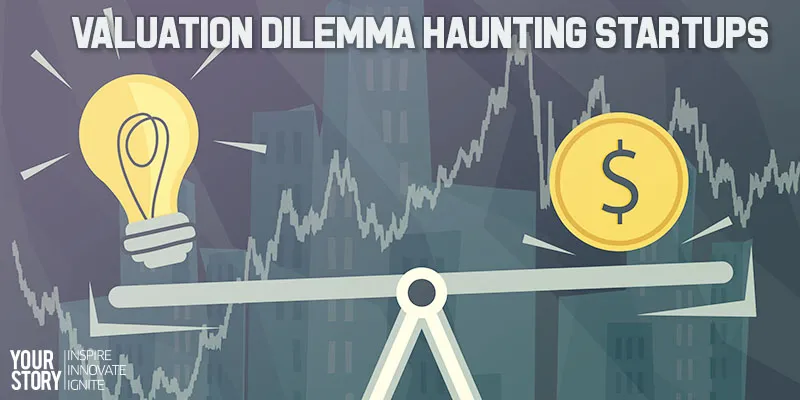Are we caught with our pants down as valuations drop, so here is why they will drop for most startups?
Last year, industry stalwarts like Mohandas Pai, Nandan Nilekani, Mahesh Murthy, and several other entrepreneurs expressed concerns over the high valuations that were offered to startups with nothing more than just ideas. These were youngsters just out of college or barely had any experience to understand what makes business sense in India. These investors had expressed even greater concerns over those gigantic valuations garnered by the e-commerce industry. In just a year global mutual fund analysts, whose parent companies backed Indian startups, have reduced the valuations of the Indian startup industry and are warning that valuations will be down across the board this year. Here is that story, just for a recap.
It is not just an Indian problem, it is global
However, for those who have not followed the developments in the mutual industry, financial services giant Morgan Stanley recently marked down Flipkart by 27 percent and valued it at $11 billion instead of the $15-billion valuation it gave the company last year. It owns less than 1.5 percent of the Indian e-commerce giant and was an investor in Flipkart’s Series-D round. It cited Flipkart's cost of acquiring the Indian customer being higher than the revenues it made as the reason.
According to CB Insights, there have been 71 down-rounds globally since 2015, indicating that this is a worldwide phenomenon. Flipkart could raise money on a down-round and its valuation could fall further by $3 billion. Xiaomi has seen a drop in valuation by $1.5 billion and Foursquare has lost $220 million.
“There is need for reality check. It seems so many ideas were funded because they seemed different,” says V Balakrishnan, Founder, Exfinity Ventures.

But what does the fall in valuations mean for the industry?
- Investors are protecting their investment and are asking founders to dilute their stake further. However, this does not mean funding will stop. It only means that investors are not going to risk it like last year, because business models have not met revenue targets in consumer and customer acquisition.
The evidence cannot be rebutted:
- Data with YourStory shows that the gloom has already begun. Last year, there were 20 companies that raised more than $100,000 and have shut shop. Since these startups were mostly founded in 2013 and 2014, this number is no significant because it was in 2015 that funding increased in Indian startups. Last year, there were 570 seed-round deals with an average deal value of $400,000 amounting to an average total size of $2.2 billion, which means that 15 percent of the total deal value went to –startups at idea-stage. This year we have seen close to 177 deals so far, and the number of deals could be lesser because of the lack of ideas that can create value.
This begs the question: has the Indian startup ecosystem exhausted its reserve of good ideas, or have investors exhausted themselves by not backing the right companies?
Or are we on the cusp of reality that is begging for the creation of a unified ecosystem between universities, research, corporate and venture capital?
“Majority of the startups will fail. There will be many new ideas coming in, which means smaller funding rounds will continue. But several existing startups will see their valuations drop if they have not created any value,” says Mohandas, MD of Aarin Capital.
In early 2015, startups in foodtech, delivery (logistics), vehicle aggregators, online grocery, home improvement services were game for raising funds. Today, several companies have shut shop. Over the last nine quarters, there were more than $15.5 billion of funds pumped into the Indian startup equation. The well-known names that bit the dust were PepperTap and Fashionara.
“Going forward, funds will look at technology as a differentiator and will ask for anchor customers,” says Naganand Doraswamy, Co-founder, IdeaSpring Capital.
How are funds bringing valuations down?
In 2015, an average startup raised the first round of $200,000 on a pre-money valuation of $500,000.
- The post money valuation would have been $700,000 (pre-money+ amount invested). Say, the founders owned 200,000 shares valued at $0.001 per share before the money was raised.
- Now that $200,000 is raised, assume you bargain to dilute 29 percent only and issue a further 200,000 shares of preference shares to the investors. Now if the value of each share is assigned as $1 per share the total number of new shares issued to founders will be 300,000 shares, whose value will be $300,000.
- But based on the pre-money valuation this will take the total tally of the founders in the common stock to 500,000 shares.
So what has happened now? Over the last year, startups have not delivered on the promise of acquiring customers or consumers, which is leading to funds tightening up.
This is how valuations dropped in the second round of financing
- Several startups have gone back to raise money and the funds have not budged on increasing the value per share, what was a $1 per share has now dropped to $.50 per share.
- Either the funds are pulling out or upping their stake in companies they feel can deliver value if they take some control. Say the startup’s founders want to raise $1 million in the second round, but the funds have reduced the value per share to only $0.50 per share. The total number of shares issued will be 500,000 shares, in this case for a $1million invested. The total shares owned in the company will be now 1.4 million (700,000 + 700,000). However, the current round will reduce the stake of the founders to 35 percent (500,000/1,400,000) because they will not get any additional shares allocated to them.
- Now if investors invoke the “ratchet” clause, which means they are tightening their grip on the new shares allocated to the founders in the first round, there will be further dilution.
- Since the additional new shares issued in round one was equivalent to $300,000, now the value paid – in the form of shares - to the investor will increase (300,000/.50) by 600,000. This means they are increasing the number of shares in the startup by diluting the value of the founders.
- The total shares in the company will increase to two million, the total preference shares will be 1.5 million and the common stock (founders stock) will remain at 500,000 shares. The dilution will be such that the funds will now own 75 percent of the company.
This is the reality that entrepreneurs have to face. Running a company without delivering on results, after taking VC money, could result in them losing control over their company.

High hopes
But the likes of Nandan Nilekani and S D Shibulal say there are good things in the years to come, as the sheer number of ideas coming from Indians is only increasing. “The quality of ideas will improve in the years to come, entrepreneurship is here to stay. This drop in valuation will reflect on business models that will not work,” says Nandan, Co-founder and former CEO of Infosys.
“Entrepreneurship is a career option today, but startups have to look beyond aggregation businesses and focus on technology as a core driver of business,” adds S D Shibulal, Co-founder and former CEO of Infosys.
Indian universities need to create an ecosystem along with the support of the government’s Startup India policy, fund houses and the corporate R&D labs. Maybe then we will have a better shot at funding startups that focus on core technology or are crazy enough to understand the pulse of the young consumer and create consumer business categories like a Tesla or WeChat.







